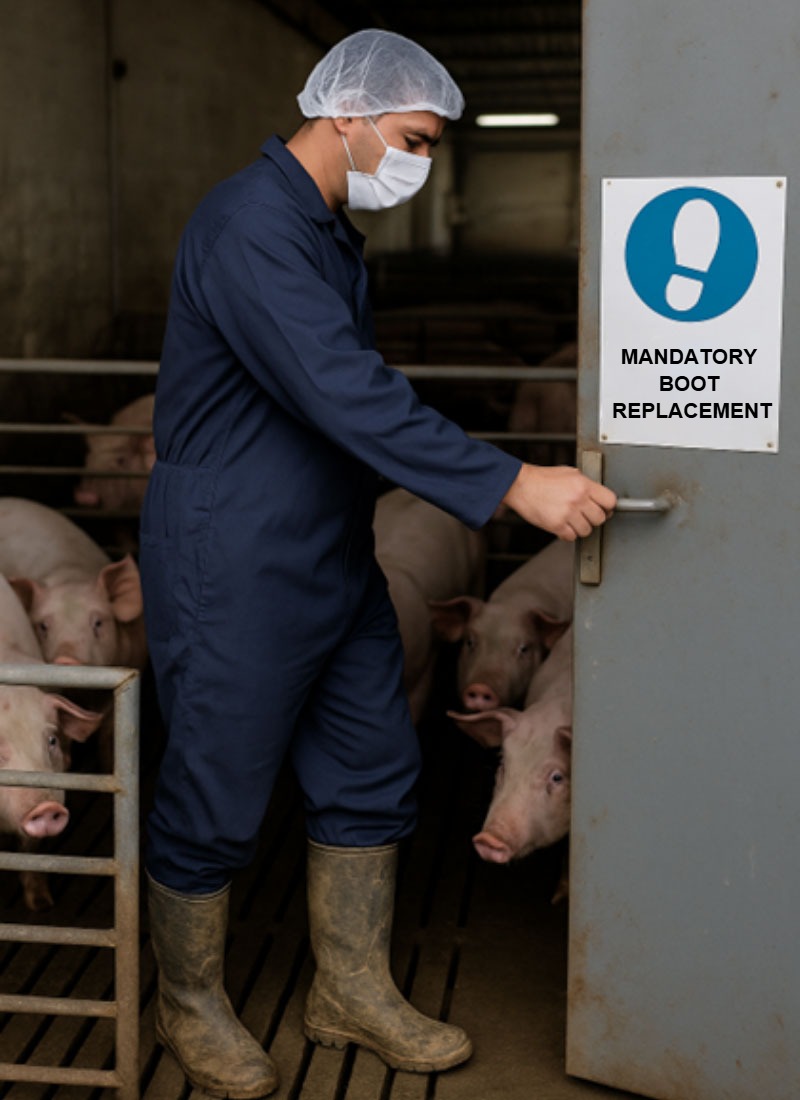In the daily operation of a pig farm, it is common to encounter situations where things do not go as expected: a step is omitted, a mistake is made, or someone deviates from protocol. When faced with these events, the immediate reaction is often to identify the “culprits” and apply sanctions. However, if we want to improve safety and well-being at work, we need to understand more precisely what is happening. Was it a mistake or a transgression? The answer changes everything.
Errors are not punished
Errors are unintentional acts. No one chooses to make mistakes. They are the result of fatigue, excessive workload, inadequate training, or limited skills to perform certain tasks.

Errors are classified into three types (James Reason, 1997):
- Slip: Automatic actions performed incorrectly, such as pressing the wrong button.
- Lapse: Failures in memory or attention, such as forgetting a step in a procedure.
- Mistake: Incorrect decisions made with good intentions, due to a lack of information or training.
Imposing penalties in these cases is not only unfair but also reduces a person's willingness to report incidents. Instead, it makes sense to ask, "What conditions allowed the error to occur? Were the instructions clear? Was the procedure realistic?"
Let's take an example from a farm: A worker administers medication to the wrong sow because he misread the identification number. His supervisor punishes him and imposes a penalty. From then on, this worker will tend to hide his mistakes to avoid further consequences, which may eventually affect the health and performance of the animals in his care in the medium or long term.
When we manage errors systematically, we stop punishing symptoms and start addressing the real causes.
Transgressions are also a sign
A transgression is when someone voluntarily breaks a rule. At first, this seems to deserve punishment. However, it would be a problem to assume that such behavior is purely individual. Evidence from the field of human factors shows the opposite (ICAO, 2023).
Most transgressions occur because working conditions facilitate, promote, or even reward them (Dekker, 2012). In other words, the problem has to do with the structure, not the person.
There are four types of transgressions:
- Routine: They become part of everyday life; everyone does it, perhaps even with their supervisors' knowledge. For example, on a farm with only two showers, workers may stop showering every time they enter the facility to save time.
- Induced: These occur when there are conflicting goals or messages. For example, complying with protocols vs. speeding up production. On a farm, workers are trained to wean healthy piglets with good weights, but they may also receive bonuses for the number of piglets weaned, which encourages them to send even stunted or sick piglets to the nursery phase in order to meet the target.
- Organizational optimization: The worker breaks a rule to benefit the company. An example of this type of transgression on a farm is when an employee decides to send pigs to slaughter even though they know that they have not met the withdrawal period requirements.
- Personal optimization: Individual benefit is sought (less effort, less time). A practical example is when workers stop weighing all piglets at farrowing because they are attending to several farrowings simultaneously.
The first three reflect system failures. If a transgression is frequent, what is needed is not punishment, but analysis: What conditions are promoting it?
We tolerate everyday transgressions... until an incident occurs

A common mistake in organizations is to punish the consequence, not the behavior. For example, many workers may skip changing their boots between areas without repercussions. This behavior is ignored or even normalized.
But on the day that cross-contamination occurs and someone who failed to comply is identified, they are punished as if their action were unique. In reality, what changed was not the behavior, but the result.
This approach punishes those who had “bad luck” and leaves intact the cultural pattern that allows everyday transgressions. If we want to prevent this, we must stop acting only when there are serious consequences and start observing habits.
What rules are only followed “when there are visitors”? What rules exist on paper but not in practice? What practices do we always tolerate, until they cause us a problem?

Manage better, punish less
Table 1. Differences between error and transgression in daily work. Comparison in the context of a pig farm.
| Aspect | Error | Transgression |
|---|---|---|
| Intention | Not intentional | Intentional |
| Common cause | Fatigue, multitasking, lack of training | Organizational culture, pressure for results, acquired habit |
| On-farm example | Forgetting to record a dose due to distraction | Ignoring biosecurity protocols because “nothing ever happens” |
| Recommended management | Review of conditions, redesign of tasks | Organizational cause analysis and system adjustments |
| Risk of poor management | Punishment reduces error reporting | Punishing without understanding perpetuates the problem |
Errors and transgressions reveal critical points in a farm's operation. Errors show human limitations. Transgressions (when there is no selfish intent) are symptoms of processes or cultures that need to be reviewed (Table 1). Both are opportunities for improvement if we stop looking for culprits and start redesigning systems that support those who work day to day.


